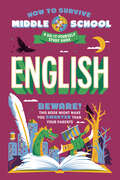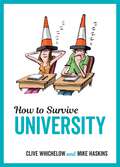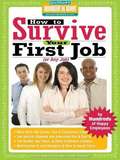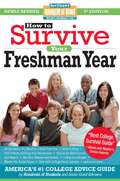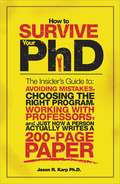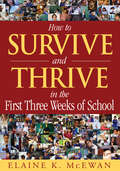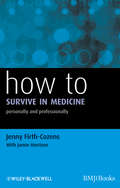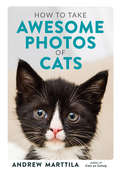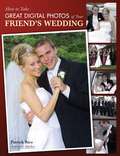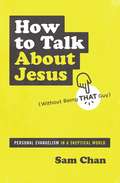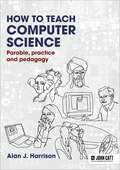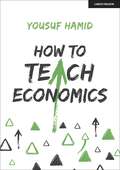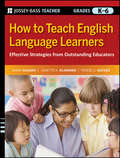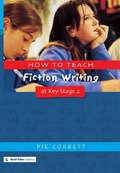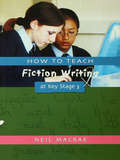- Table View
- List View
How to Survive Middle School: A Do-It-Yourself Study Guide (HOW TO SURVIVE MIDDLE SCHOOL books)
by Rachel Ross Maria Ter-MikaelianBEWARE—THIS BOOK MIGHT MAKE YOU SMARTER THAN YOUR PARENTS! Navigate the wilderness of middle school Science with this hands-on, comprehensive study guide for 6th-8th graders!This highly illustrated, handy field guide makes learning an adventure inside and outside of the classroom. Study with helpful illustrations, detailed tables, diagrams, and charts, essential vocabulary lists, and expert knowledge presented in a fun, bold, and easy-to-understand format. Explore and master topics like: • The Scientific Method • The solar Systems • Fossil Fuels and Climate Change • The Periodic Table • Chemical Bonds • Ecosystems • Cells • Speed, Velocity, and Acceleration • Laws of Motion • and more! The How to Survive Middle School study guides cover essential middle school subjects with interactive texts, useful study techniques, and engaging illustrations that make information stick! The included reflective questions and write-in sections foster critical thinking and problem-solving skills, helping readers become independent learners. Each book is vetted by curriculum experts to perfectly complement middle school lesson plans. Other available subjects: World History, English, Math, and U.S. History.
How to Survive Middle School: A Do-It-Yourself Study Guide (HOW TO SURVIVE MIDDLE SCHOOL books)
by Nina CiattoBEWARE—THIS BOOK MIGHT MAKE YOU SMARTER THAN YOUR PARENTS! Navigate the wilderness of middle school English with this hands-on, comprehensive study guide for 6th-8th graders!This highly illustrated, handy field guide makes learning an adventure inside and outside of the classroom. Study with helpful illustrations, annotated excerpts, writing prompts, essential vocabulary lists, and expert knowledge presented in a fun, bold, and easy-to-understand format. Explore and master topics like: • Grammar and Roots of Language • Metaphors, Symbols, & other Literary Devices • Types of Fiction and Nonfiction • Textual Analysis • Sources and Evidence • Tone and Voice • Narrative Themes • and more! The How to Survive Middle School study guides cover essential middle school subjects with interactive texts, useful study techniques, and engaging illustrations that make information stick! The included reflective questions and write-in sections foster critical thinking and problem-solving skills, helping readers become independent learners. Each book is vetted by curriculum experts to perfectly complement middle school lesson plans. Other available subjects: World History, Math, Science, and U.S. History.
How to Survive Third Grade
by Laurie LawlorA satisfying, realistic story about a third-grade boy and his attempts to fit in and be liked at school.
How to Survive University
by Clive Whichelow Mike HaskinsAt last, no more parents! But who’s going to do your washing, and bail you out when you’re short of cash? Hmm, you’re going to need survival skills. This mischievous little book will help you see through your university years with tongue-in-cheek advice and cheeky illustrations.
How to Survive University
by Clive Whichelow Mike HaskinsAt last, no more parents! But who’s going to do your washing, and bail you out when you’re short of cash? Hmm, you’re going to need survival skills. This mischievous little book will help you see through your university years with tongue-in-cheek advice and cheeky illustrations.
How to Survive University: An Essential Pocket Guide
by Tamsin KingWhether your passion is society life, studying or shots, your university experience will hold both new adventures and fresh challenges. This guide is packed with tips to help you survive and thrive at uni, from pulling an all-nighter in the library to an all-nighter at the club.
How to Survive University: An Essential Pocket Guide
by Tamsin KingWhether your passion is society life, studying or shots, your university experience will hold both new adventures and fresh challenges. This guide is packed with tips to help you survive and thrive at uni, from pulling an all-nighter in the library to an all-nighter at the club.
How to Survive Your First Job or Any Job
by Ricki FrankelIn this informational and necessary book, hundreds of gainfully employed young people detail their experiences launching their careers. They offer real-world tips and advice on looking for and landing a first job, doing well at work, and simply hanging in there. Their stories cover the gamut of work life - dealing with difficult bosses, weird coworkers, less-than-ideal environments and tasks, and climbing up (or slipping down) the corporate ladder, from those who have been there, done that, and lived to tell about it.
How to Survive Your Freshman Year
by Frances Northcutt Yadin Kaufmann Ed.D. Scott Silverman Mark W. BernsteinHow to Survive Your Freshman Year offers incoming college freshmen the experience, advice, and wisdom of their peers: hundreds of other students who have survived their first year of college and have something interesting to say about it. Based on interviews with hundreds of college students at every type of higher-learning institution across the country, this book has insights on every aspect of college life, including, what to take to the dorm, living with roommates, Facebook and other social networks, extracurricular activities, choosing classes, studying, going abroad, finances, food, the social scene, doing laundry, staying in touch with friends and family, and much more. Highly readable, much of the book consists of short snippets with some interesting insight and advice from the college students interviewed. The book also includes expert input from college advisors and officers.
How to Survive Your Phd
by Jason R. KarpOf use to any advanced grad student, or anyone who thinks they might become one, this book offers viable, common-sense advice to problems that may seem insurmountable from within the halls of academe. Karp, who holds a PhD in exercise physiology, describes in concrete, practical terms the goals and priorities needed to select a PhD program and, once in it, to maximize the experience. He's especially acute in describing the mindset needed to excel in research, on the one hand, and the diplomatic skills and savvy needed to achieve a good working relationship with advisors, on the other. The volume is not indexed. Annotation ©2010 Book News, Inc. , Portland, OR (booknews. com)
How to Survive and Thrive in the First Three Weeks of School
by Elaine K. McEwan-AdkinsBest-selling author Elaine McEwan demonstrates how teaching routines, rubrics, and rules during the first three weeks of school leads to higher achievement through the rest of the year!
How to Survive in Medicine: Personally and Professionally (How To)
by Jenny Firth-CozensMedicine is a career that most people consider to be enviable. Whatever one's criteria for a good job, being a doctor ticks a lot of boxes: doctors are needed, respected, well remunerated and can make a difference between life and death Increasingly, doctors are experiencing stress, depression and anxiety, fuelled by the increasing demands of the health services, and the lack of resources to support them. Focussing on the causes, symptoms and management of psychological problems experienced by doctors at all stages in their careers, this book considers the difficulties and stressors of medicine as a career, linking to studies that look at what interventions are successful in the workplace and offering various solutions. Including: A study based over 20 years of doctors' stress factors Case histories to bring the subject to life Guidance on choosing a specialty, dealing with difficult people, stress and demands 37 A valuable resource both for trainers and doctors alike.
How to Take Awesome Photos of Cats
by Andrew MarttilaA fun and practical guide to taking the perfect pics of your cat from the photographer of Cats on Catnip -- a great gift for the feline fanatic in your life. If you or someone you know loves a cat, chances are they love taking pictures of their cat, too. But cats can be tricky little guys to photograph -- they move quickly when you want them to stay still and are sedentary logs when you're going in for an action shot. Add to that all the variables of shooting indoors vs. outdoors, and it can be a difficult job. Enter How to Take Awesome Photos of Cats, where professional cat photographer and popular Instagrammer Andrew Marttila (Cats on Catnip, Shop Cats of New York) walks you through all the steps you need to know to take perfect photos of your favorite feline. This lighthearted, gifty guide includes dozens of photos and shares practical information for both amateur photographers and experts alike, all told in a fun, accessible, and lighthearted way. Whether you're looking to take better photos with your phone or you're trying to master the settings on your digital camera, this is the book that tells you everything you need to know to take awesome snaps of cats.
How to Take Great Digital Photos of Your Friend's Wedding
by Patrick RiceArmed with a digital camera, wedding attendees can create snapshots of the their friend's big day with the camera, lighting, posing, and composition skills taught in this step-by-step manual. Beginning with a discussion of digital capture basics and how to ensure the best possible exposure by selecting the appropriate ISO settings, photographers learn how to create the setting that produces the best results under any lighting conditions. Posing is also covered so that, armed with some general principles and strategies, amateur photographers can greatly improve their sense of portraiture. Sections on unusual situations teach readers how to make the best of mixed lighting conditions, flatter subjects, avoid exposure problems, and use the flash indoors; while tips on using Adobe Photoshop Elements help photographers give their photographs that professional edge.
How to Take the Ex Out of Ex-Boyfriend
by Janette RallisonSixteen-year-old Giovanna Petrizzo finds it hard enough to fit in. Three years since her family moved to Texas, she's still the newcomer compared to everyone around her. It doesn't help matters when her twin brother, Dante, takes on the mayor's son by running for class president. The least she could expect, though, would be for her boyfriend, Jesse, to support their cause. But Jesse's apparent defection triggers Giovanna's rash emotional side, and before she knows it, she's turned Jesse from the boy of her dreams to the ex boyfriend she dreams of winning back. In her trademark style, Janette Rallison delivers a laugh-out-loud romantic comedy that only leaves readers wanting more.
How to Talk about Jesus (Without Being That Guy): Personal Evangelism in a Skeptical World
by Sam ChanMost Christians know they should be trying to tell their friends and family about Jesus. But in a post-Christendom world, personal evangelism is viewed negatively--it's offensive, inappropriate, and insensitive. Recent studies confirm that the majority of Christians rarely evangelize, worried they might offend their family or lose their friends. In How to Talk About Jesus (Without Being That Guy), author Sam Chan equips everyday Christians who are reluctant and nervous to tell their friends about Jesus with practical, tested ways of sharing their faith in the least awkward ways possible.Drawing from over two decades of experience as an evangelist, teacher, and pastor, Chan explains why personal evangelism feels so awkward today. And utilizing recent insights from communication theory, cross-cultural ministry, and apologetics, he helps you build confidence in sharing your faith, and teaches you how to evangelize your friends and family in socially appropriate ways.
How to Teach Adults
by Dan SpaldingYour hands-on guide to teaching adults. . . no matter what the subjectIn this expanded edition of How to Teach Adults, Dan Spalding offers practical teaching and classroom management suggestions that are designed for anyone who works with adult learners, particularly new faculty, adjuncts, those in community colleges, ESL teachers, and graduate students. This reader-friendly resource covers all phases of the teaching process from planning what to teach, to managing a classroom, to growing as a professional in the field.How to Teach Adults can guide new instructors who are trying to get up to speed on their own or can help teacher trainers cover what their students need to know before they get in front of a class. It is filled with down-to-earth tips and checklists on such topics as connecting with adult students, facilitating discussions, and writing tests, plus everything you need to remember to put into your syllabus and how to choose the right textbook. Dan Spalding reveals what it takes to teach all students the skills they need to learn, no matter what the topic or subject matter.Full of vivid examples from real-world classrooms, this edition:Shows how to get started and tips for designing your courseIncludes information for creating a solid lesson planGives suggestions for developing your teacher personaHow to Teach Adults offers the framework, ideas, and tools needed to conduct your class or workshop with confidence.
How to Teach Balanced Reading and Writing
by Bonnie Burns"Any teacher can use this book regardless of the reading program a district may be using. It brings the various practices of reading and writing together in a practical and useful way." -Betty Ann Collinge, Kindergarten/First Grade Teacher Green Acres Elementary School, North Haven, CT "This book′s major strengths include straightforward writing, clear discussion of topics, excellent graphic samples, strong attention to a balanced perspective, and practical ideas." -Jennifer Trujillo, Assistant Professor, Teacher Education Fort Lewis College"The book is easy to follow and very accessible. It is not too esoteric or philosophical, yet includes important theory and knowledge about learning. The suggestions are excellent, relevant, and inclusive." -Karen Heath, Literacy Coordinator Barre Schools, VT Use these practical strategies to help students develop strong reading and writing skills! Reading is a complex process. And in today′s increasingly diverse classrooms, each student has unique learning needs. In the face of these challenges, how can teachers ensure that all students develop essential literacy skills? How to Teach Balanced Reading and Writing provides practical, research-based strategies for all aspects of literacy education. Presenting best practices in an easy-to-use format, literacy expert Bonnie Burns supplies guidance for providing direct instruction in phonics, using authentic texts, building word recognition, strengthening comprehension, and implementing writing across the curriculum. Aligned with the National Reading Panel Report (2000) and Reading First legislation, this book offers strategies to use with students at all developmental levels. This second edition has been extensively revised to include · A discussion of language acquisition Strategies for assessing phonemic awareness Techniques for developing fluency Increased attention to the needs of diverse learners Additional instructional activities in every chapter Because of its flexibility, this book is suitable for both novice and experienced teachers. Its friendly, accessible format also makes it an ideal text for preservice teachers and students in education courses.
How to Teach Computer Science: Parable, practice and pedagogy
by Alan J. HarrisonThis book is for new or aspiring computer science teachers wishing to improve their subject knowledge and gain confidence in the classroom. And it's for experienced computer science teachers who wish to hone their practice, in particular in the areas of explicit instruction, tackling misconceptions and exploring pedagogical content knowledge. You will read some of the backstory to our subject – the "hinterland" – those fascinating journeys into history that make the subject come alive and place it in historical context. These stories will help you to enrich your lessons, cement core knowledge, develop cultural capital and help you excite a life-long love for the subject. We will go beyond the mark scheme to explore the subject knowledge behind the answers, giving you the confidence to discuss the field in greater depth, enabling you to use explicit instruction methods: presenting skills and concepts clearly and directly enabling student mastery. We will explore misconceptions that arise when teaching our subject, so you can "head them off at the pass". And we will look at teaching ideas – the pedagogical content knowledge (PCK) – exploring the helpful analogies, questions and activities that work for each topic: practices that can be lifted and dropped straight into the classroom to immediately enhance your teaching. Trainee or pre-service teachers, NQTs and early-career teachers will find this book invaluable, experienced teachers will find it inspiring, and all will benefit from a fresh look at the hinterland and subject pedagogy that makes computer science a fascinating subject to teach.
How to Teach Computer Science: Parable, practice and pedagogy
by Alan J. HarrisonThis book is for new or aspiring computer science teachers wishing to improve their subject knowledge and gain confidence in the classroom. And it's for experienced computer science teachers who wish to hone their practice, in particular in the areas of explicit instruction, tackling misconceptions and exploring pedagogical content knowledge. You will read some of the backstory to our subject – the "hinterland" – those fascinating journeys into history that make the subject come alive and place it in historical context. These stories will help you to enrich your lessons, cement core knowledge, develop cultural capital and help you excite a life-long love for the subject. We will go beyond the mark scheme to explore the subject knowledge behind the answers, giving you the confidence to discuss the field in greater depth, enabling you to use explicit instruction methods: presenting skills and concepts clearly and directly enabling student mastery. We will explore misconceptions that arise when teaching our subject, so you can "head them off at the pass". And we will look at teaching ideas – the pedagogical content knowledge (PCK) – exploring the helpful analogies, questions and activities that work for each topic: practices that can be lifted and dropped straight into the classroom to immediately enhance your teaching. Trainee or pre-service teachers, NQTs and early-career teachers will find this book invaluable, experienced teachers will find it inspiring, and all will benefit from a fresh look at the hinterland and subject pedagogy that makes computer science a fascinating subject to teach.
How to Teach Economics
by Yousuf HamidEconomics teachers often work by themselves or in small departments. This can mean they are forced to plan a lot of lessons from scratch with limited scope for shared planning or collaboration.Even as teaching becomes more research-informed, there is still the problem of having to work out how this best applies when teaching Economics, especially when there has been limited training in this.This can mean teachers are forced to adopt a trial-and-error approach, attempting to implement generic teaching and learning tips into economics lessons.Teachers plan each explanation individually, only learning what common misconceptions are through the painstaking experience of seeing puzzled expressions on multiple pupils' faces over the years. This book aims to change that.By looking at what the latest cognitive science research tells us about how pupils learn and crucially how that can be implemented in economics lessons, this book provides a short-cut to that trial-and-error approach.While the book summarises what the research tells us about pupil learning, this is fundamentally a ‘doing’ book.It is packed with practical examples of how research can be implemented in Economics lessons looking at explanations, misconceptions, assessment, curriculum and much more.
How to Teach Economics
by Yousuf HamidEconomics teachers often work by themselves or in small departments. This can mean they are forced to plan a lot of lessons from scratch with limited scope for shared planning or collaboration.Even as teaching becomes more research-informed, there is still the problem of having to work out how this best applies when teaching Economics, especially when there has been limited training in this.This can mean teachers are forced to adopt a trial-and-error approach, attempting to implement generic teaching and learning tips into economics lessons.Teachers plan each explanation individually, only learning what common misconceptions are through the painstaking experience of seeing puzzled expressions on multiple pupils' faces over the years. This book aims to change that.By looking at what the latest cognitive science research tells us about how pupils learn and crucially how that can be implemented in economics lessons, this book provides a short-cut to that trial-and-error approach.While the book summarises what the research tells us about pupil learning, this is fundamentally a ‘doing’ book.It is packed with practical examples of how research can be implemented in Economics lessons looking at explanations, misconceptions, assessment, curriculum and much more.
How to Teach English Language Learners
by Diane Haager Terese C. Aceves Janette K. KlingnerThis hands-on book offers teachers a much-needed resource that will help maximize learning for English Language Learners (ELLs). How to Teach English Language Learners draws on two wide-ranging teacher quality studies and profiles eight educators who have achieved exceptional results with their ELL students. Through highly readable portraits, the authors take readers into these teachers' classrooms, illustrating richly what it is they do differently that yields such great results from English learners. Because most teachers profiled work within a three-tiered Response-to-Intervention framework, the book shows how to implement RTI effectively with ELLs--from providing general reading instruction for the entire classroom to targeted interventions with struggling students. Written by noted ELL educators Diane Haager, Janette K. Klingner, and Terese Aceves, How to Teach English Language Learners is filled with inspiring success stories, teaching tips, activities, discussion questions, and reflections from these outstanding teachers.
How to Teach Fiction Writing at Key Stage 2 (Writers' Workshop Ser.)
by Pie CorbettHow to Teach Fiction Writing is a practical manual to help teachers of junior classes to focus on the key aspects of developing children's storywriting. The book presents a series of essential writing workshops full of creative ideas and fun activities. It also offers a range of advice including how to set up and run an effective workshop and how t
How to Teach Fiction Writing at Key Stage 3
by C Neil MacraeHow to Teach Fiction Writing at Key Stage 3 is a practical manual to help teachers of 11-14 year-olds to develop effective modeling and scaffolding strategies for the teaching of narrative writing. Using a step-by-step approach, based on the 'word/sentence/text level' convention, the book shows how teachers can help pupils to build work in various genres and to move out from these to more complex writing. Each section has a workshop approach that leads into a narrative writing activity, giving pupils the chance to complete a fully realized piece of work at the end each time. The workshops focus on genre features, the craft of the writer, and specific year-related needs (taken from the KS3 Framework). The book has a clear progression through KS3, and extension and support activities for the most and least able pupils are provided as an integral part of each section.

